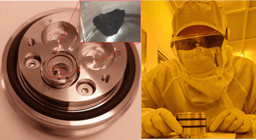The evolution of organic material on Asteroid 162173 Ryugu and its delivery to Earth
Published in Astronomy

Carbonaceous Asteroid Sample Return
The Hayabusa-2 mission was first in carbonaceous asteroid sample return on its ~ 4.5 billion km journey, retrieving ~5 g of sub mm- to cm- sized fragments of Asteroid 162173 Ryugu. Two sites were sampled by touch-and-go (TAG) on the equator of Ryugu, the first from regolith and the second at crater material ejected at lower depths by a ballistic. Samples from both TAG sites on the equator of Ryugu are of the most hydrated and organic-rich meteoritic, carbonaceous chondrite (CC) composition – CI (Ivuna type). Hydrothermal alteration pervades them, lacking any distinct primary components from the solar nebular, and consisting mainly of water derived, secondary minerals including phyllosilicate, (Fe, Ni) sulphides, Fe-oxides, carbonates and phosphates. CI chondrites are however among the least abundant CC group in Earth's meteorite record. That said, Ryugu’s CI composition does not seem unique to this asteroid. More recently in September 2023, the OSIRIS REx spacecraft returned samples from Asteroid 101955 Bennu. Hundreds of grams have been curated from the sample return capsule (the aim of the mission was 50 g) from a region north of Bennu by TAG. Bennu grains have also been shown to be CI like Ryugu.
The Relationship between Phyllosilicate and Organic Material in Ryugu
Samples of Ryugu and Bennu provide the first insight into early Solar System prebiotic evolution from known planetary bodies. The major phyllosilicate phase in them is interlayered saponite and serpentine. This phyllosilicate surrounds micron to submicron macromolecular organic particles known as insoluble organic matter. We have been coordinating focused ion beam-scanning electron microscopy tomography with scanning transmission X-ray microscopy and transmission electron microscopy on Hayabusa-2 samples to characterise the morphology, functional chemistry and distribution of organic material in situ. We found that a wider-spread diffuse organic component is preserved within the phyllosilicate, more aliphatic-, carboxylic-rich, and aromatic-poor than the organic particles. This diffuse organic material is likely a mixture of acid insoluble and water/organic soluble molecules. Carboxyl/aromatic ratios in the diffuse organic matter of Ryugu are characteristic of CI and the most altered CCs, indicating the role of aqueous alteration in its formation. Some organic particles additionally formed to completely surround phyllosilicate itself, meaning that the soluble organic bearing diffuse organic matter is contained within some of the macromolecular organic particles by aqueous alteration on Ryugu.

The Delivery of Biologically Relevant Molecules to Early Earth
The action water and organics from the early Solar System led to the formation of micron-sized polymeric organic objects encapsulating biologically relevant molecules in phyllosilicate that were delivered more frequently to early Earth, and less so today. The survival of organic material upon impact with planetary atmospheres is dependent on the type of biologically relevant molecules delivered to the surfaces of terrestrial planets. By feeding in constraints on the abundances, and physicochemical properties of both phyllosilicate and organic polymeric particles encapsulating phyllosilicate from the early Solar System, can a clearer picture be made on the delivery of biologically relevant materials prior to the occurrence of life on Earth.
Follow the Topic
-
Nature Communications

An open access, multidisciplinary journal dedicated to publishing high-quality research in all areas of the biological, health, physical, chemical and Earth sciences.
Related Collections
With Collections, you can get published faster and increase your visibility.
Women's Health
Publishing Model: Hybrid
Deadline: Ongoing
Advances in neurodegenerative diseases
Publishing Model: Hybrid
Deadline: Dec 24, 2025


Please sign in or register for FREE
If you are a registered user on Research Communities by Springer Nature, please sign in